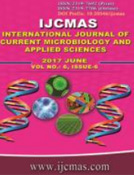


 National Academy of Agricultural Sciences (NAAS)
National Academy of Agricultural Sciences (NAAS)

|
PRINT ISSN : 2319-7692
Online ISSN : 2319-7706 Issues : 12 per year Publisher : Excellent Publishers Email : editorijcmas@gmail.com / submit@ijcmas.com Editor-in-chief: Dr.M.Prakash Index Copernicus ICV 2018: 95.39 NAAS RATING 2020: 5.38 |
Spot blotch caused by Bipolaris sorokiniana is major disease problem in warm and humid areas of South Asian and other countries. Host resistance is an effective method to manage it and varieties with resistance to spot blotch and rusts are preferred. The stem rust resistant gene Sr2 along with other Sr genes is widely used in wheat and Triticale breeding programme to provide resistance against stem rust pathotypes including new Ug99 (TTKS). The presence of Sr2+ is also associated with morphological marker, pseudo black chaff (PBC) character, a dark pigmentation on the glumes, peduncle and below stem internodes of wheat. A total of 136 numbers of diverse genotypes of wheat and triticale having Sr2+ gene in sole and in combination with other Sr genes (Sr5+, Sr5+, Sr7b+, Sr8b+, Sr9b+, Sr9e+, Sr11+, Sr13+, Sr24+, Sr30+, Sr31+) were evaluated against spot blotch under artificially inoculated and epiphytotics at ten hot spot locations in northern plains agro ecological zones in India during 2000-01 to 2011-12 crop seasons. Based on scoring of spot blotch severity on top two leaves at mild milk stage, the genotypes were categorization of in to R, MR, MS and S category. A total of 69.9% of genotypes possessing Sr2+ genes were susceptible to spot blotch. Twenty genotypes possessing gene combinations of Sr2+5+, Sr2+5+24+, Sr2+5+3, Sr2+8b+11+, Sr2+9e+11+, and Sr2+24+ were all susceptible to spot blotch. The resistant and susceptible genotypes with Sr2+ gene were 30.1 and 69.9%, respectively. The results suggests that Sr2 and other stem rust resistant genes may be used cautiously in varieties meant for warm and humid regions where main spot blotch and leaf rust are major diseases.
 |
 |
 |
 |
 |